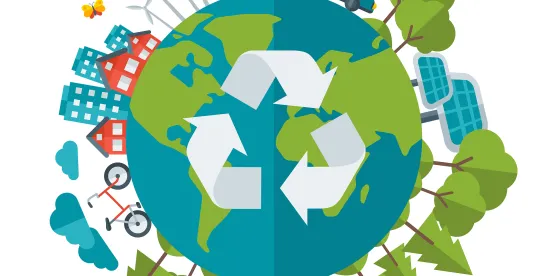A new and powerful wave of “greenwashing”1 bans will sweep the European Union (EU) shortly. The EU’s Green Claims Directive and Greenwashing Directive2 (together, the Green Directives) are key legislative tools being introduced in the EU as part of the European Green Deal, focused on combatting misleading claims regarding products’ environmental friendliness or social consciousness.
BACKGROUND TO THE GREEN DIRECTIVES
The European Commission’s (the Commission) aim is to reduce “greenwashing” claims across the EU market and provide consumers more generally with accurate information when making their purchasing decisions. The Commission has noted that many environmental claims made by brands trading in Europe are currently not reliable and that consumer trust in them is extremely low. Indeed, a Commission study published in 2022 identified that 56% of EU consumers stated that they had encountered misleading environmental claims.3 This was noted as part of a wider willingness amongst EU consumers to contribute to a greener and more circular economy in their everyday lives with the ability to make sustainable consumption choices at the point of sale.4
So, what does this mean for consumer brands?
In this alert, we provide quick-fire responses to the key issues that brands should be aware of as a result of the changes introduced by the Green Directives, and which will have significant operational and cost impacts for consumer brands.
What Is the Implementation Timeline for the Green Directives?
It is clear that the Green Directives denote a watershed moment for brands in the types of claims they can make in their sales and marketing strategies, packaging, and product labelling, and brands should start preparing for the implementation of the new requirements sooner rather than later given their potentially major operational and cost implications.
For the already-adopted Greenwashing Directive, EU Member States have until 27 March 2026 to transpose it into their national laws, with enforcement expected to commence later that year.
The Green Claims Directive is currently undergoing the legislative process at EU level. Negotiations among the co-legislators to agree on a final text, the so-called trilogues, are expected to start in autumn. It is likely that the Green Claims Directive will not be adopted before the beginning of 2025, followed by a two-year transposition period for EU Member States lasting until around early 2027.5
However, consumer brands should be mindful that there is already existing legislation that has been adopted by some EU Member States which must already be complied with in this area.
What Is Being Introduced? What Changes Are the Green Directives Making?
Currently, EU law does not specifically regulate environmental claims, but they are subject to a generic set of rules under consumer laws, which state that marketing claims should not be misleading, inaccurate or untruthful, among other requirements. The current obligations are set under the Misleading and Comparative Advertising Directive 2006/114/EC, the Unfair Business-to-Consumer Practices Directive 2005/29/EC and the Consumer Rights Directive 2011/83/EU.
The Greenwashing Directive focuses on creating a common methodology for substantiating green claims and making information on claims readily available to consumers.
The Green Claims Directive provides an outright ban on generic environmental claims, imposes stringent environmental labelling requirements and introduces obligations on brands to provide clear and relevant information concerning environmental or social claims.
The Green Directives are, however, complementary and include several areas of overlap, not least in relation to prohibited practices concerning environmental claims.
What Do You Mean by Environmental Claims and What Will the Green Directives Cover?
“Environmental claims” are defined very broadly in the Greenwashing Directive as: “any message or representation which is not mandatory under Union or national law, in any form, including text, pictorial, graphic or symbolic representation, such as labels, brand names, company names or product names,…and which states or implies that a product, product category, brand or trader has a positive or zero impact on the environment or is less damaging to the environment than other products.”6
Such a broad definition will inevitably capture the vast majority of green marketing claims a brand intends to make. Careful assessment under the rules of the Green Directives will therefore be required prior to making any such claims.
It is currently unclear whether implicit environmental claims, such as use of environmental themed colours or images on product packaging (as is customary for products such as personal care goods), will also be targeted in the future, but additional care certainly needs to be taken when using these.
What Is the Key Rule if I Wish to Make a Green Claim About My Product?
In short, substantiation, more detailed claims and getting such claims verified by a third party (see below). Any environmental claim you make needs to be carefully considered and backed up by evidence.
Whilst guidance on the Greenwashing Directive is still awaited, Recital 9 provides an illustrative example of what would be acceptable: a “climate-friendly packaging” claim would not comply with the Greenwashing Directive due to it being too generic. However, replacing it with “100% of energy used to produce this packaging comes from renewable sources” (provided this can be substantiated) would be appropriate.
Article 3(1) of the Green Claims Directive sets out practical steps on how such an assessment should be undertaken. When contemplating an environmental claim to be added to a product:
- Consider specifying the aspect of the product or life cycle that the claim applies to.
- Provide scientific evidence for the claim.
- Demonstrate objectively how the claimed environmental impact is significant and is better than mere compliance with law or common practice.
- Clarify whether the claimed environmental benefits result in any negative environmental impact.
- Separate greenhouse gas emissions offsets from greenhouse gas emissions reductions.
Enhanced substantiation will also be required for any comparative or future environmental performance:
- Comparative claims (i.e. where it is stated or implied that a product or brand has a lower or higher environmental impact or demonstrates a better or worse performance from an environmental perspective compared to other products or brands) will need to be based on “like‑for‑like” information and assessments.
- Environmental claims relating to future performance (i.e. transition to carbon or climate neutrality or similar claims) will need to be linked to specific, time bound improvement milestones to which the company commits.
Brands should provide full background information that supports the claim e.g. via web link or QR code on the packaging.
Will Some Claims Be Completely Banned? Which Ones?
Yes. The Greenwashing Directive explicitly prohibits brands from using “generic” environmental claims.
Recital 9 of the Greenwashing Directive provides a useful non-exhaustive list illustrating what would be considered generic claims. These include statements such as carbon-neutral, eco-friendly, biodegradable, natural, ecological, biobased, gentle on environment, eco and climate friendly, among many others.7
The key takeaway here is that if you want to make a green claim, be as specific as possible. Detail will be key. How is your product carbon neutral? What is the exact carbon dioxide offsetting volume? How have you tested this? Generic green statements with no verifiable substance will “no longer fly”.
Are There Any Other Areas That Will Impact My Marketing Claims Under the Green Directives?
The Green Directives not only relate to environmental claims but also to social responsibility claims.
Brands will need to ensure that information provided on the social characteristics of a product throughout its value chain are not misleading.
The Greenwashing Directive specifically references that claims relating to the following topics must be backed by facts: gender equality, inclusion and diversity, quality and fairness of working conditions, adequate wages, social protection, safety of work environment, and contributions to social initiatives and ethical commitments e.g. animal welfare.8
Is There Any Way I Can Check Whether My Green Claims Are Compliant?
The new rules state that you as a business must verify your green claims before they are communicated.
This includes verification by an officially accredited body, which will be independent and be established by each EU Member State. Such a process should provide comfort for brands in respect of any enforcement action by national competent authorities.
However, the latest amendments to the Green Claims Directive proposed by the Council of the EU aim to minimise the burden and cost on companies to obtain verification from third parties on the substantiation of environmental claims and introduce a simplified procedure for certain claims. Under the simplified procedure, certain claims will be exempt from the third-party verification process but will rather require completion of a technical document prior to the claim’s publication, and such document should be held on record.
Will These Green Directives Have an Impact on Product Labelling? I Have Been Using My Own-Branded Eco Labelling on Product Packaging for Years.
This is another crucial change that the new rules will bring. Companies will no longer be able to use their own eco labelling. Instead, brands will only be able to use such labels if they are based on official certification schemes. You will therefore need to remove own-branded green labels from products.
The EU’s Ecolabel9 scheme is expected to be one such scheme likely to meet these criteria, but the demand for other official certification labels means other national and EU schemes may need to be established.
What if I Do Not Comply With the Green Directives and Just Take the Risk?
Penalties for non-compliance will differ from EU Member State to EU Member State, but these can be severe and include fines of up to 4% of a company’s turnover in the EU Member State(s) concerned, confiscation of revenues from the infringing product and temporary exclusion (for up to 12 months) from public procurement processes.
There has been a recent uptick of enforcement of green claims in the EU and the Green Directives are likely to strengthen that.
How Can You Be Prepared?
Specific steps will depend on the consumer brands’ products and business, but you should be thinking about the following:
- Carrying out an audit on usage of green claims that could be problematic.
- Establishing where your green claims require additional substantiation or may need to be dropped if no back-up data is available.
- Keeping under review verification schemes at a national and EU level.
- Dropping your own green labels and switching to official labelling schemes.
- Reviewing or preparing internal processes for the use of green claims.
- Delivering training for marketing and development teams.
Noncompliance may not only have a financial impact on brands, but also tarnish their image and reputation among consumers and lead to complicated legal and public relations processes. In addition, all business units involved from product development through to marketing will need to be closely lined up and coordinated to ensure compliance with the new EU rules. Thus, a pragmatic and proactive approach in ensuring compliance will save brands a significant headache in the longer term.
Footnotes
1 https://commission.europa.eu/strategy-and-policy/priorities-2019-2024/european-green-deal_en.
2 2023/0085/COD, Directive (EU) 2024/825 also known as Empowering Consumers for the Green Transition (ECGT) Directive.
3 https://ec.europa.eu/commission/presscorner/detail/en/fs_22_2099.
5 https://eur-lex.europa.eu/procedure/EN/2023_85.
6 Article 1(b)(o) of Directive (EU) 2024/825.
7 Recital 9 of Directive (EU) 2024/825.
8 Recital 3 of Directive (EU) 2024/825.
9 https://environment.ec.europa.eu/topics/circular-economy/eu-ecolabel_en.









 />i
/>i
